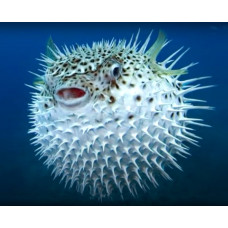Latin name
Takifugu rubripes
Other names
Tiger puffer, torafugu.
Identification
The body is covered with barbs. Vertebrae: 21-22. This species is able to inflate into a balloon when it senses danger. They do this with the help of a large air sac that comes from the stomach.
Features of fish fins
Dorsal fin has 16-19 soft rays, anal fin has 13-16 soft rays, no hard rays.
Fish colouring
On the flanks, behind the pectoral fins, there is a large round black spot surrounded by a white ring.
Distribution
Northwest Pacific: western part of the Sea of Japan, East China Sea and Yellow Sea north to Muroran, Hokkaido, Japan.
Habitat
A deep-water subtropical Asian species that inhabits marine and brackish waters of the northwestern Pacific Ocean. Adults remain in bays, sometimes penetrating into brackish waters. Juveniles are often found in brackish estuaries. As they grow, they move away from the coast.
Size
Total body length reaches up to 80 centimeters, but is usually around 40 centimeters.
Behavior
Neritic demersal (bottom) non-migratory fish found at depths down to 100 m. They live singly.
Food and feeding habits
The Japanese puffer fish feeds on clams, crabs and worms. Their teeth are hard plates that allow them to gnaw through shells and mollusks.
Reproduction
Spawning takes place in the sea from March to May. The eggs are attached to rocks in quiet places at a depth of about 20 meters.
Fishing
A highly profitable fishery. This fish is now farmed commercially in Japan.
Relationship with a person
The liver and ovaries of these fish are fatally poisonous. The intestines are less toxic. The flesh, skin, and testes are not poisonous. It is a valuable food fish in Japan. It is used in Chinese medicine.
Interesting facts
The Japanese puffer (Takifugu rubripes) puffs up and takes the shape of a balloon by capturing air or water with its mouth. This helps them escape from predatory fish — after all, not every predator dares to grab a balloon. Once the danger has passed, they return to their normal appearance.
| Classification | |
| Phylum | Chordata |
| Class | Actinopterygii |
| Squad | Tetraodontiformes |
| Family | Tetraodontidae |
| Genus | Takifugu |
| Species | T. rubripes |
| Features | |
| Conservation status | Near Threatened |
| Habitat | Bottom |
| Life span, years | No information |
| Maximum body weight, kg | No information |
| Maximum length, cm | 89 |
| Sailing speed, m/s | No information |
| Threat to people | Edible |
| Way of eating | Bentophage |
Japanese puffer
Tags: japanese puffer



